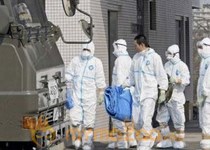The crisis at Japan’s Fukushima nuclear power plant, the level of which has been raised from five to seven, the worst on an international scale, may ultimately exceed the level of Chernobyl, the plant’s operator said Tuesday.
Authorities have been battling to keep the power plant under control, after three explosions and a fire occurred at four reactors following a devastating magnitude-9 earthquake and ensuing tsunami that struck the Pacific coastal areas of northeastern and eastern Japan March 11.
The amount of radiation released at the plant was equivalent to 10 percent of that in the Chernobyl accident, Xinhua reported citing the Nuclear and Industrial Safety Agency.
The agency said the plant has been releasing 10,000 terabecquerels of radioactivity per hour, which is an official benchmark for a level-7 event, according to RIA Novosti.
The consequences of the accident at the plant may ultimately exceed the level of Chernobyl, a spokesman for Tokyo Electric Power Co. (TEPCO), the plant’s operator, said Tuesday.
“The radiation leak has not stopped completely and our concern is that the amount of leakage could eventually reach that of Chernobyl or exceed it,” Kyodo News quoted the official as saying.
Level-7 on the International Nuclear and Radiological Event Scale (INES) has so far only been applied to the 1986 Chernobyl disaster.
The level describes an accident as a “major event” and leads to “a major release of radioactive material with widespread health and environmental effects”.
The Chernobyl accident occurred April 26, 1986, at the eponymous nuclear power plant in Ukraine. An explosion and fire released large quantities of radiation that spread over much of Western Russia and Europe. It is considered the worst nuclear power plant accident in history, and the only one classified as a level-7 event.
Two plant workers had died on the night of the accident and 28 others died within a few weeks as a result of radiation poisoning.
The earlier level-5 of the crisis level at the Fukushima plant was also applied to the Three Mile Island accident in the US in 1979.
A cooling malfunction caused part of the core to melt in the No.2 reactor at the Three Mile Island nuclear power plant near Middletown, Pennsylvania, March 28, 1979.
The accident was the most serious in US commercial nuclear power plant history, even though it led to no deaths or injuries to workers or residents.
Level-5 is described as an “accident with wider consequences”, which leads to a “limited release of radioactive material”.
According to Japan’s National Police Agency, 13,116 people have been confirmed dead while 14,377 were still unaccounted for till Monday.
About 151,000 survivors were staying in 2,300 shelters across the country.
A series of quakes and aftershocks has occurred since the March 11 catastrophic incident. On Tuesday, an earthquake of magnitude 6.4 jolted Chiba prefecture, east of Tokyo, while a magnitude 5.5 quake rocked Nagano prefecture in central Japan, the Japan Meteorological Agency said.







